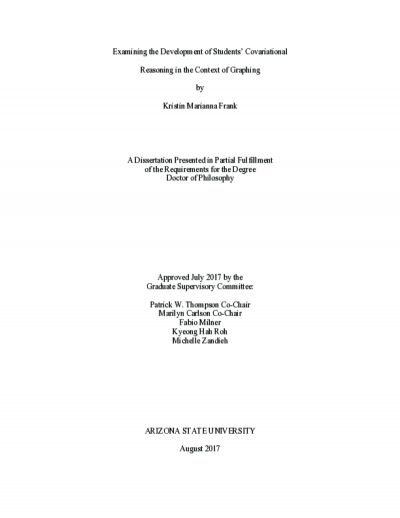Description
Researchers have documented the importance of seeing a graph as an emergent trace of how two quantities’ values vary simultaneously in order to reason about the graph in terms of quantitative relationships. If a student does not see a graph as a representation of how quantities change together then the student is limited to reasoning about perceptual features of the shape of the graph.
This dissertation reports results of an investigation into the ways of thinking that support and inhibit students from constructing and reasoning about graphs in terms of covarying quantities. I collected data by engaging three university precalculus students in asynchronous teaching experiments. I designed the instructional sequence to support students in making three constructions: first imagine representing quantities’ magnitudes along the axes, then simultaneously represent these magnitudes with a correspondence point in the plane, and finally anticipate tracking the correspondence point to track how the two quantities’ attributes change simultaneously.
Findings from this investigation provide insights into how students come to engage in covariational reasoning and re-present their imagery in their graphing actions. The data presented here suggests that it is nontrivial for students to coordinate their images of two varying quantities. This is significant because without a way to coordinate two quantities’ variation the student is limited to engaging in static shape thinking.
I describe three types of imagery: a correspondence point, Tinker Bell and her pixie dust, and an actor taking baby steps, that supported students in developing ways to coordinate quantities’ variation. I discuss the figurative aspects of the students’ coordination in order to account for the difficulties students had (1) constructing a multiplicative object that persisted under variation, (2) reconstructing their acts of covariation in other graphing tasks, and (3) generalizing these acts of covariation to reason about formulas in terms of covarying quantities.
This dissertation reports results of an investigation into the ways of thinking that support and inhibit students from constructing and reasoning about graphs in terms of covarying quantities. I collected data by engaging three university precalculus students in asynchronous teaching experiments. I designed the instructional sequence to support students in making three constructions: first imagine representing quantities’ magnitudes along the axes, then simultaneously represent these magnitudes with a correspondence point in the plane, and finally anticipate tracking the correspondence point to track how the two quantities’ attributes change simultaneously.
Findings from this investigation provide insights into how students come to engage in covariational reasoning and re-present their imagery in their graphing actions. The data presented here suggests that it is nontrivial for students to coordinate their images of two varying quantities. This is significant because without a way to coordinate two quantities’ variation the student is limited to engaging in static shape thinking.
I describe three types of imagery: a correspondence point, Tinker Bell and her pixie dust, and an actor taking baby steps, that supported students in developing ways to coordinate quantities’ variation. I discuss the figurative aspects of the students’ coordination in order to account for the difficulties students had (1) constructing a multiplicative object that persisted under variation, (2) reconstructing their acts of covariation in other graphing tasks, and (3) generalizing these acts of covariation to reason about formulas in terms of covarying quantities.
Download count: 1
Details
Title
- Examining the development of students' covariational reasoning in the context of graphing
Contributors
- Frank, Kristin Marianna (Author)
- Thompson, Patrick W (Thesis advisor)
- Carlson, Marilyn P (Thesis advisor)
- Milner, Fabio (Committee member)
- Roh, Kyeong Hah (Committee member)
- Zandieh, Michelle (Committee member)
- Arizona State University (Publisher)
Date Created
The date the item was original created (prior to any relationship with the ASU Digital Repositories.)
2017
Subjects
Resource Type
Collections this item is in
Note
- thesisPartial requirement for: Ph.D., Arizona State University, 2017
- bibliographyIncludes bibliographical references (pages 294-301)
- Field of study: Mathematics
Citation and reuse
Statement of Responsibility
by Kristin Marianna Frank

